
Aristida is a very nearly cosmopolitan genus of plants in the grass family. Aristida is distinguished by having three awns (bristles) on each lemma of each floret. The genus includes about 300 species found worldwide, often in arid warm regions. This genus is among those colloquially called three-awnswiregrasses, speargrasses and needlegrasses. The name Aristida is derived from the Latin "arista", meaning "awn".
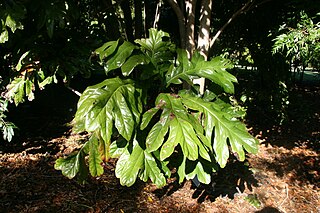
Athertonia is a monotypic genus of plants in the family Proteaceae. The sole described species is Athertonia diversifolia, commonly known as Atherton oak, athertonia, creamy silky oak or white oak. It is endemic to a small part of the Wet Tropics of Queensland, Australia. A relative of the macadamia, it has potential in horticulture and the bushfood industry.
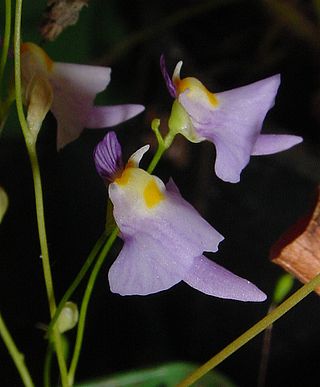
Utricularia warburgii is a species of terrestrial bladderwort found in China, where it grows in sunny wet meadows at an altitude of 900 m. It belongs to the section Nigrescentes and is closely related to U. caerulea.

Chionanthus ramiflorus, commonly known as northern olive or native olive, is a species of shrubs and trees, of the flowering plant family Oleaceae. They grow naturally in India, Nepal, northeastern Australia (Queensland), New Guinea, the Philippines, southern China and Taiwan.

Ficus fraseri, the white sandpaper fig or shiny sandpaper fig, is one of several fig species commonly known as sandpaper figs. It is native to New South Wales, Queensland and the Northern Territory in Australia and to New Caledonia and Vanuatu. Other common names are "figwood" and "watery fig".

Myrsine howittiana, the brush muttonwood or muttonwood, is a shrub or small tree in the family Primulaceae. The species is endemic to eastern Australia.
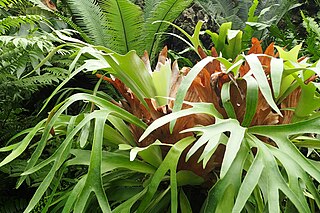
Platycerium bifurcatum, the elkhorn fern or common staghorn fern, is a species of fern native to Java, New Guinea and eastern Australia, in New South Wales, Queensland and on Lord Howe Island. It is a bracket epiphyte occurring in and near rainforests. Growing to 90 cm (35 in) tall by 80 cm (31 in) broad, it has heart-shaped sterile fronds 12–45 cm (5–18 in) long, and arching grey-green fertile fronds which are forked and strap-shaped, and grow up to 90 cm (35 in) long.

Angiopteris evecta, commonly known as the king fern, giant fern, elephant fern, oriental vessel fern, Madagascar tree fern, or mule's Foot fern, is a very large rainforest fern in the family Marattiaceae native to most parts of Southeast Asia and Oceania. It has a history dating back about 300 million years, and is believed to have the longest fronds of any fern in the world.

Opisthiolepis is a genus of a sole described species of large trees, constituting part of the plant family Proteaceae. The species Opisthiolepis heterophylla most commonly has the names of blush silky oak, pink silky oak, brown silky oak and drunk rabbit.

Lasjia is a genus of five species of trees of the family Proteaceae. Three species grow naturally in northeastern Queensland, Australia and two species in Sulawesi, Indonesia. Descriptively they are the tropical or northern macadamia trees group. Lasjia species characteristically branched compound inflorescences differentiate them from the Macadamia species, of Australia, which have characteristically unbranched compound inflorescences and only grow naturally about 1,000 km (620 mi) further to the south, in southern and central eastern Queensland and in northeastern New South Wales.

Dysoxylum arborescens, commonly known in Australia as Mossman mahogany, is a small tree in the mahogany family Meliaceae. It is native to rainforests of Malesia, Papuasia, Queensland and nearby islands.

Dysoxylum parasiticum, commonly known as yellow mahogany, is a species of rainforest tree in the family Meliaceae native to Taiwan, parts of Malesia, Papuasia, and northeast Queensland.

Eucalyptus odontocarpa, commonly known as Sturt Creek mallee, is a mallee that is native to northern Australia. Indigenous Australians know the plant as Warilyu.

Salix mesnyi is a species of willow native to southern and eastern China, Taiwan, and Vietnam. It can be found among shrubs near water growing 15 metres (49 ft) tall.
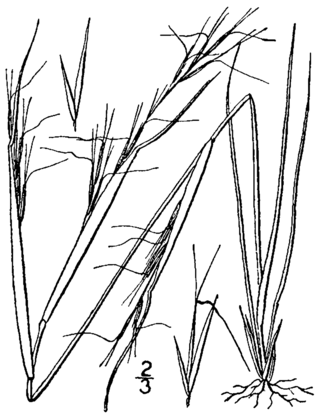
Aristida basiramea, the forked three-awn, is a species of grass in the family Poaceae native to North America. The specific epithet basiramea means "branching from base".
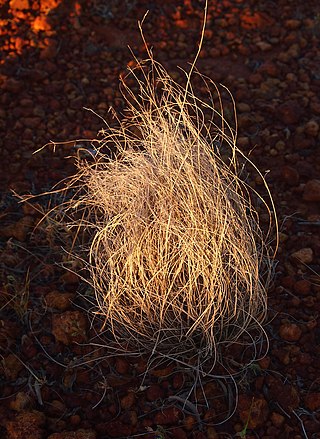
Aristida contorta, commonly known as bunched kerosene grass, kerosene grass, bunched windgrass, silvergrass, mulga grass,sand speargrass, and medicine grass, is a species of grass in the family Poaceae that is native in Australia. The Walmajarri name for this species is Ngirrirli.

Aristida calycina, commonly known as dark wiregrass, is a species of grass in the family Poaceae that is native in Australia.

Palaquium galactoxylum, commonly known as Cairns pencil cedar, Daintree maple or red silkwood, is a species of very large tree in the family Sapotaceae which is endemic to rainforests of New Guinea and northern Australia. It can produce spectacularly large buttress roots.

Aristida ramosa is a species of grass that occurs in New South Wales, Victoria, Western Australia and Queensland. However, it is thought to have been introduced into Western Australia. It was first described by Robert Brown in 1810 who find it live at Port Jackson (Sydney). The species epithet, ramosa, is a Latin adjective meaning "branched" which describes the plant as bearing branches.




















